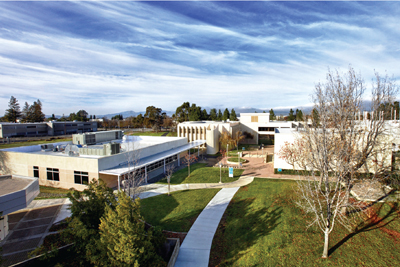
After 30 years of research into how things burn, it was fitting that at the grand opening of the Combustion Research Computation and Visualization (CRCV) facility, the ribbon wasn’t cut with the traditional pair of oversized scissors. Instead, it was torched by Div. 8000 VP Rick Stulen (8000), Eric Rohlfing of DOE’s Office of Science, and Stephen Goguen of DOE’s Office of Energy Efficiency and Renewable Energy (EERE).
The grand opening of the CRCV marks the start of a new chapter for the Combustion Research Facility (CRF), harnessing the power of supercomputers to further understand and develop combustion processes. Bob Carling (8300), director of the CRF, recalled the origins of the facility in the nuclear weapons program.
“Back during the time of the oil embargo, some folks here thought you could use the lasers from the nuclear weapons program to interrogate combustion systems. The idea was that with research and collaborative work with scientists and engineers from around the world, you could improve combustion processes, from the point of view of both better efficiency and reduced pollutants,” he said.
Bob recalled how, 30 years ago, the CRF began with one big laser piped to a few different labs, a model that worked for a time. Eventually lasers became so ubiquitous that most labs in the CRF have several — an evolution similar to that of computers. Back when the CRF was first opened, scientists and engineers were still using punch cards to run programs. Today, noted Bob, computers are so common that everyone has one on their hip.
“The founding concept of the CRF remains the same, to bring together people from throughout the world to work collectively with our scientists and engineers,” he said. “As we’ve evolved from heavy experimental work, we know and understand that to face the next challenges in combustion we need sophisticated models and predictive capabilities.”
The new collaborative research facility will serve as a focal point to accelerate the realization of predictive modeling and simulation for combustion. The CRCV will provide interactive data visualization and collaborative workspaces, as well as a 2,000-square-foot machine room for the dedicated computational capability. Sandia is in the process of achieving LEED certification for the use of “green” technologies in the building’s construction.
Collaboration is ‘outstanding’
The CRCV is cofunded by the DOE’s Office of Science and EERE. Rohlfing, director of the chemical sciences, geosciences, and biosciences division at the Office of Science, noted that this partnership, while unique, is one that DOE would like to replicate elsewhere. He has a distinct vantage point, as both an alumni of the CRF — he recalled working with one of those facility lasers — and now as a leader at one of the funding organizations.
“The collaboration between Basic Energy Science and EERE’s vehicle technologies program is outstanding and effective. This is probably one of the only examples where these two organizations have come together to fund a modest, yet very effective, building,” he said. “The work that this building will facilitate is a natural part of the evolution of combustion science and technology and we are delighted to help cosponsor it.”
Goguen, a senior engineer in EERE’s office of vehicle technologies, commented that proof of the CRF’s success is visible on roads everywhere. He recalled as a child seeing big belches of black smoke coming off buses and spewing from big trucks, something that doesn’t exist anymore, thanks, in part to the CRF.
“It’s amazing, but at the same time, you’d think there’d be a penalty to be paid, but there wasn’t. In that same time period, the efficiency of engines also has gone up significantly. From what I saw today, walking around and listening to new ideas being explored in the labs, it’s a new beginning,” he said.
In the audience at the grand opening were current and past CRF researchers, including former Div. 8000 VP Tom Cook, who oversaw the startup of the CRF. Also on hand were regional elected officials and their representatives and educators from Las Positas College, the University of California, Davis, and the University of Michigan. Rick received certificates of commendation from US Representatives John Garamendi and Jerry McNerney, State Assemblymember Joan Buchanan, State Senator Loni Hancock, the Alameda County Board of Supervisors, and the City of Livermore.
“This facility represents a very important step toward the accomplishment of the innovation hub, i-GATE, which the City of Livermore, other Tri Valley cities, Sandia, and Lawrence Livermore National Lab have been working on for over a year,” said Jeff Williams, a Livermore city council member. “Speaking on behalf of the surrounding cities and region, Livermore enthusiastically supports the new opportunities that this capability brings to the area and we congratulate Sandia and DOE for taking the bold step of creating and building this facility.”
To conclude the program, two invited speakers spoke of the history and future of large-scale computing. Jeffrey Nichols, associate lab director at Oak Ridge National Laboratory, gave a talk on complexity and how work done at the CRCV will aid researchers in making sense of massive volumes of data. Daniel Haworth, a professor of mechanical engineering at Pennsylvania State University, led the audience on journey through the history of computational combustion.